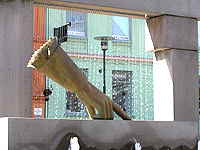 Oslo, Norway offers a wide range of cultural experiences.
Oslo, Norway offers a wide range of cultural experiences.
In 2004, we finally “discovered” Scandinavia, and fell in love with the beauty of the countries, the culture, the cuisine and the people. In August 2005 we set out to discover more of Scandinavia, this time our destination was Norway.
We flew SAS Scandinavian Airlines and were once again impressed with the SAS hospitality that began at check-in, and continued to the Business Lounge, and throughout the flight. Some airlines these days really “get it” when it comes to making the passengers’ trip enjoyable, and they are certainly one of them. Their Business Lounge provides a small taste of Scandinavian in its design, snacks, drinks and magazines. The Business Lounge in Newark has free Internet usage, as well as several small rooms where passengers can relax or have a pre-flight meeting. Once on board, we relaxed with a welcome glass of champagne, enjoyed dinner and a few movies before falling to sleep. Unfortunately, for this trip, we did not bring our laptops, but wished that we did, as SAS now is the world’s first airline to offer wireless high-speed Internet access in all passenger classes. Imagine being able to check your email anytime during the flight! We flew from Newark to Stockholm, Sweden, and then caught a quick flight to our final destination, Oslo, Norway.
Once we arrived at the airport in Oslo, we took the Airport Express Train from the airport to the city centre, which only takes 20 minutes whereas a taxi will take about 45 minutes to 1 hour. We not only saved time, but money besides. We bought our train tickets at the airport however according to their brochure, you can also purchase the ticket by swiping your bankcard (Visa, Eurocard/Mastercard, Diners, American Express or SAS TPS/SAS SCC) through the e-ticket card reader prior to boarding the Airport Express Train.
Oslo is the capital of Norway, and is the oldest of the Scandinavian capitals. Oslo offers something for everyone with a wide variety of accommodations, excellent restaurants, shopping, museums, fjords and mountains to engage its visitors in a variety of activities. We spent two nights in Oslo, and were determined to see as much of this charming city as we could.
We purchased the Oslo Pass, which is good for free or reduced admission to 25 museums and sights, may be used for free travel on public transportation, and also for free parking. We explored the city center, stopping in the 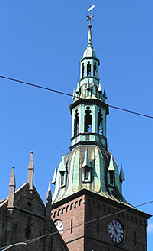 Oslo Domkirke, (Oslo Cathedral), Stortorget 1, which was consecrated in 1697, and is a Lutheran church where the Royal weddings take place. The church’s steeple dates back to 1850, the ornate mosaic ceilings were decorated between 1936-1950, and there are beautiful stained glass windows by Emanuel Vigeland. We passed the statue of Christian IV, and the Stortinget (Parliament Building).
Oslo Domkirke, (Oslo Cathedral), Stortorget 1, which was consecrated in 1697, and is a Lutheran church where the Royal weddings take place. The church’s steeple dates back to 1850, the ornate mosaic ceilings were decorated between 1936-1950, and there are beautiful stained glass windows by Emanuel Vigeland. We passed the statue of Christian IV, and the Stortinget (Parliament Building).
We visited the new Nobel Peace Center, located at Rådhusplassen, which opened on June 11, 2005, in an old railroad center circa 1872. Norway has the 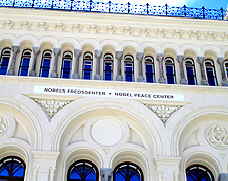 responsibility for the Nobel Peace Prize, and the Nobel Committee selects the winner based on the criteria set in Alfred Bernhard Nobel’s will “…the person(s) who shall have done the most or the best work for brotherhood between nations, for abolition or reduction of standing armies and for arranging and for promoting peace processes..” The prize is awarded each December 10th at Oslo City Hall on the anniversary of Alfred Nobel’s death on December 10, 1896. We found the Nobel Peace Center to be very interesting and informative. The Oslo Pass can be used for free admission.
responsibility for the Nobel Peace Prize, and the Nobel Committee selects the winner based on the criteria set in Alfred Bernhard Nobel’s will “…the person(s) who shall have done the most or the best work for brotherhood between nations, for abolition or reduction of standing armies and for arranging and for promoting peace processes..” The prize is awarded each December 10th at Oslo City Hall on the anniversary of Alfred Nobel’s death on December 10, 1896. We found the Nobel Peace Center to be very interesting and informative. The Oslo Pass can be used for free admission.
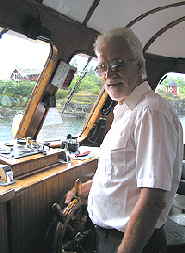 Oslo is surrounded by fjords and must be experienced by boat to truly appreciate its beauty. We took a 2-hour Fjord Sightseeing cruise on Båtservice Sightseeing, Pier 3, (Rådhusbrygge 3 in front of City Hall) and were delighted with Astri’s narration in English, as she told us about the Fortress that was built in 1299, the charming colorful summer houses along the coast in traditional colors of green, red, yellow and blue which dotted the waterside, past Rabbit Island and the oldest lighthouse in the Oslo Fjord which was built in 1826. We learned that the deepest part of the Oslo Fjord is 152 meters, and passed the interesting bathing houses, which had a small hole in the floor, where people could enter the water and swim naked in the dark. During prohibition, the houses were used to sell alcohol.
Oslo is surrounded by fjords and must be experienced by boat to truly appreciate its beauty. We took a 2-hour Fjord Sightseeing cruise on Båtservice Sightseeing, Pier 3, (Rådhusbrygge 3 in front of City Hall) and were delighted with Astri’s narration in English, as she told us about the Fortress that was built in 1299, the charming colorful summer houses along the coast in traditional colors of green, red, yellow and blue which dotted the waterside, past Rabbit Island and the oldest lighthouse in the Oslo Fjord which was built in 1826. We learned that the deepest part of the Oslo Fjord is 152 meters, and passed the interesting bathing houses, which had a small hole in the floor, where people could enter the water and swim naked in the dark. During prohibition, the houses were used to sell alcohol.
In the evening, we had dinner at Lofoten Fiskerestaurant located at Aker Brugge, Stranden 75, which offers spectacular views of the Oslo fjord as well as the Akershus Castle. 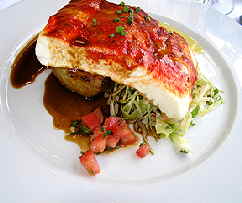 The restaurant has an excellent selection of seafood. The Eternal Peace Flame, which was inaugurated on September 12, 2002, is located just outside the restaurant on the pier. Read about Lofoten Fiskerestaurant in our Restaurants section and read Chefs' Recipes where Chef de Cuisine Anders Svahnstrøm shares 2 of his recipes.
The restaurant has an excellent selection of seafood. The Eternal Peace Flame, which was inaugurated on September 12, 2002, is located just outside the restaurant on the pier. Read about Lofoten Fiskerestaurant in our Restaurants section and read Chefs' Recipes where Chef de Cuisine Anders Svahnstrøm shares 2 of his recipes.
The next day, we took a tour of Oslo. Anne Holstad, our guide from Oslo Guidbureau told us that the Akershus Fortress dates back to the 1300’s and is the oldest building left in Oslo. The Akershus Castle is a medieval castle from the 13th century and is the former residence of Kings and Queens, but today is used only for government representation. Oslo was founded in 1000, but had frequent fires, so in 1624, the King moved the city and dictated that houses must be built of brick. Norway has a population of 4.5 million inhabitants, and Oslo has over half a million inhabitants. In 2005, Norway celebrated its 100th anniversary of independence from Sweden.
We passed the National Theatre where they will celebrate Henrik Ibsen (1828-1906) with citywide centennial events throughout the year in 2006, the Royal Garden, Ibsen Museum, Nobel Prize Institute with a statue of Alfred Bernhard Nobel (1833-1896), and visited the fashionable west side of Oslo.
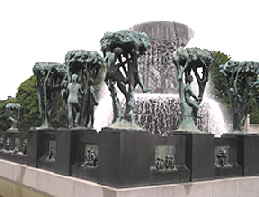 We also had the opportunity to visit Vigeland Park, Nobelsgate 32, a stunning park of 400 acres, which showcases over 200 of Gustav Viegland’s sculptures. Gustav Vigeland (1869 – 1943) was a prolific sculptor and some of his interesting works at the park include his wrought iron gates, and 58 bronze sculptures on the Bridge including the famous The Angry Boy sculpture. We walked around the Fountain, a sculpture of six giants carrying a large vessel, which is bordered by 20 bronze trees in which he shows the cycle of life as well as capturing a variety of human emotions throughout the lifecycle. Also interesting was a 17 meter granite Monolith which has 121 human figures, but we found his 36 granite sculptures of human interaction the most touching. There is also a rose garden and stone labyrinths. Vigeland Park is open 24 hours everyday. There is no admission fee.
We also had the opportunity to visit Vigeland Park, Nobelsgate 32, a stunning park of 400 acres, which showcases over 200 of Gustav Viegland’s sculptures. Gustav Vigeland (1869 – 1943) was a prolific sculptor and some of his interesting works at the park include his wrought iron gates, and 58 bronze sculptures on the Bridge including the famous The Angry Boy sculpture. We walked around the Fountain, a sculpture of six giants carrying a large vessel, which is bordered by 20 bronze trees in which he shows the cycle of life as well as capturing a variety of human emotions throughout the lifecycle. Also interesting was a 17 meter granite Monolith which has 121 human figures, but we found his 36 granite sculptures of human interaction the most touching. There is also a rose garden and stone labyrinths. Vigeland Park is open 24 hours everyday. There is no admission fee.
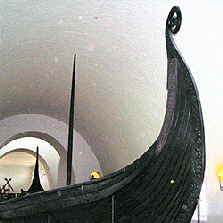 Our next stop was to The Viking Ship Museum (Vikingskiphuset) Huk Aveny 35, Bygdøy, an interesting museum with well preserved Viking ships, including the Oseberg ship, the Gokstad ship and the Tune ship, as well as Viking artifacts including clothing, and furniture. The Viking Age was from 800 – 1050 AD, and Vikings came from Denmark, Norway and Sweden. Admission is charged, but children under 7 years old are free. Hours are from 9:00 am – 6:00 pm from May until the end of September, and from 11:00 am – 4:00 pm from October until the end of April. The Oslo Pass can be used for free admission.
Our next stop was to The Viking Ship Museum (Vikingskiphuset) Huk Aveny 35, Bygdøy, an interesting museum with well preserved Viking ships, including the Oseberg ship, the Gokstad ship and the Tune ship, as well as Viking artifacts including clothing, and furniture. The Viking Age was from 800 – 1050 AD, and Vikings came from Denmark, Norway and Sweden. Admission is charged, but children under 7 years old are free. Hours are from 9:00 am – 6:00 pm from May until the end of September, and from 11:00 am – 4:00 pm from October until the end of April. The Oslo Pass can be used for free admission.
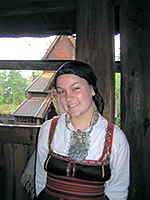 Continuing with our cultural knowledge, we visited the Norsk Folkemuseum, Museumsvn. 10, N, and is also called the Norwegian Museum of Cultural History. The open-air museum features authentic buildings from different regions of Norway, as well as guides wearing regional traditional clothing. Julie Andersen, our guide at their 1738 house from Hove in Heddal, Telemark brought 1738 to life as she described the furnishings as well as the significance of her clothing. The large silver broaches were considered status symbols at that time. She also explained how girls covered their hair with either a hat or a scarf depicted their marital as well as social status. Today, girls receive a traditional costume between the ages of 14 – 15 years old, at the time of their confirmation, which they will wear at special holidays. The Oslo Pass can be used for free admission.
Continuing with our cultural knowledge, we visited the Norsk Folkemuseum, Museumsvn. 10, N, and is also called the Norwegian Museum of Cultural History. The open-air museum features authentic buildings from different regions of Norway, as well as guides wearing regional traditional clothing. Julie Andersen, our guide at their 1738 house from Hove in Heddal, Telemark brought 1738 to life as she described the furnishings as well as the significance of her clothing. The large silver broaches were considered status symbols at that time. She also explained how girls covered their hair with either a hat or a scarf depicted their marital as well as social status. Today, girls receive a traditional costume between the ages of 14 – 15 years old, at the time of their confirmation, which they will wear at special holidays. The Oslo Pass can be used for free admission.
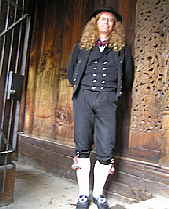 Steiner Aga, our guide at the Stave Church from Gol, Hallingdal, explained that it is the oldest building at the museum, and dates to early 1200, and is one of the original stave churches. Around 1652, paintings were added. Admission is charged, check their website for their hours.
Steiner Aga, our guide at the Stave Church from Gol, Hallingdal, explained that it is the oldest building at the museum, and dates to early 1200, and is one of the original stave churches. Around 1652, paintings were added. Admission is charged, check their website for their hours.
After our city tour, we had lunch at the Grand Café at the historic Grand Hotel, located at Karl Johans gate 5, which opened in 1874, and is where Henrik Ibsen had lunch everyday. Read about the Grand Café in our Restaurants section and read Chesfs' Recipes where Executive Chef Bjørn Artz and Sous Chef Andre Wels share 2 of their recipes.
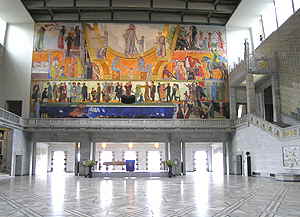 After lunch, we continued exploring the city, and went to Oslo City Hall (Rådhuset), located at Fridtjof Nansens plass, a stunning building, which was opened in 1950, and is the seat of political management. The building has wonderful frescoes, ornate ceilings and paintings by famous artists including Edvard Munch (1863-1944). Outside there are 16 wooden friezes depicting various folklore themes by the painter and sculptor, Dagfin Werenskiold (1892–1977). Admission is charged, but children under 12 years old are free. Oslo City Hall is open from May until the end of August from 9:00 am – 5:00 pm, and from September until the end of April from 9:00 am – 4:00 pm. The Oslo Pass can be used for free admission.
After lunch, we continued exploring the city, and went to Oslo City Hall (Rådhuset), located at Fridtjof Nansens plass, a stunning building, which was opened in 1950, and is the seat of political management. The building has wonderful frescoes, ornate ceilings and paintings by famous artists including Edvard Munch (1863-1944). Outside there are 16 wooden friezes depicting various folklore themes by the painter and sculptor, Dagfin Werenskiold (1892–1977). Admission is charged, but children under 12 years old are free. Oslo City Hall is open from May until the end of August from 9:00 am – 5:00 pm, and from September until the end of April from 9:00 am – 4:00 pm. The Oslo Pass can be used for free admission.
 We visited The National Museum of Art, Architecture and Design to see their expansive collection of paintings by such celebrated artists as Evard Munch and Pablo Picasso, as well as their impressive collection of sculpture. The museum also has a gift shop and café. We also stopped to see the Kiss the Frog exhibit at The Art of Transformation. Check their website for hours and admission information. Although we visited as many of the museums in Oslo as we could during our short stay, alas we really only covered the tip of the iceberg, which certainly gives us plenty of reasons to return to Oslo.
We visited The National Museum of Art, Architecture and Design to see their expansive collection of paintings by such celebrated artists as Evard Munch and Pablo Picasso, as well as their impressive collection of sculpture. The museum also has a gift shop and café. We also stopped to see the Kiss the Frog exhibit at The Art of Transformation. Check their website for hours and admission information. Although we visited as many of the museums in Oslo as we could during our short stay, alas we really only covered the tip of the iceberg, which certainly gives us plenty of reasons to return to Oslo.
We also managed to do some shopping at Christiania Glasmagasin, and at Steem & Sturm, both of which are located in the city center.
For our last evening in Oslo, we had dinner at Theatercaféen at the Hotel Continental, Stortingsgaten 24/26. 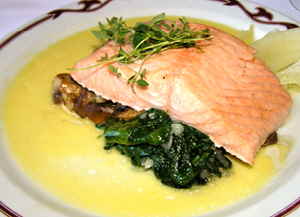 The 350-seat Theatercaféen opened in 1900, is the largest Vienna style café in Europe, and is consistently on the New York Times list of the 10 most famous cafés in the world. Great ambience, food, service and live piano music made it the perfect ending to our Oslo trip. Read about Theatercaféen in our Restaurants section and read Chef's Recipes where Chef de Cuisine Nils Jøren Aas shares 2 of his recipes.
The 350-seat Theatercaféen opened in 1900, is the largest Vienna style café in Europe, and is consistently on the New York Times list of the 10 most famous cafés in the world. Great ambience, food, service and live piano music made it the perfect ending to our Oslo trip. Read about Theatercaféen in our Restaurants section and read Chef's Recipes where Chef de Cuisine Nils Jøren Aas shares 2 of his recipes.
Although most Norwegians speak English, we always like to learn some basic vocabulary to assist us when traveling. This list should help you to get around Norway.
| English | Norwegian |
| Hello | Hallo |
| Goodbye | Farvel |
| Good morning | God morgen |
| Good afternoon | God ettermiddag |
| Good night | God natt |
| Yes | Ja |
| No | Nei |
| Thank you | Tusen takk |
| You're welcome | Velbekomme |
| Where is? | Hvor er? |
| Close by? | Noer? |
| Far? | Langt borte? |
| Open? | Åpent? |
| Closed? | Lukket? |
| Coffee | Kaffe |
| Tea | Te |
| Milk | Melk |
| Beer | Øl |
| Wine | Vin |
| White wine | Hvitwin |
| Red wine | Rødvin |
| Bread | Brød |
| Cheese | Ost |
| Meat | Kjøtt |
| Fish | Fisk |
| Salad | Salat |
| Vegetarian | Vegetarisk |
Next stop, Kirkenes, Norway coming in a future edition.
For other articles on Norway, please read our articles in the Restaurants and Chefs' Recipes sections.
For more information on Norway, please visit: www.visitnorway.com, www.invanor.no and www.visitoslo.com.
© October 2005. Luxury Experience. www.luxuryexperience.com All rights reserved.


